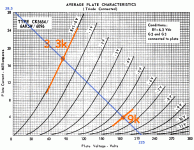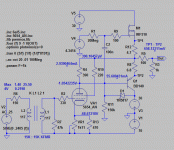Seems I've read that the plate load resistor should be 3 to 5 times the plate resistance. If the plate resistance is 7.7k in the stock configuration and the plate load resistor is only 4.7k what effect will that have?> With a B+ of 68v from my bench supply:
> Plate to cathode: 50.65 v
> Cathode to ground: 0.715 v
Plots plop-on the 6AK5 curves. rp is around 7.7k. Gain is 15 or 20. Zout near 3k.
Or is that ratio not all that important?
Linearity arrives from a constant ΔE/ΔI quotient in all operating voltages of the grid. When you look at the anode curves you can draw a line, representing the load of your tube. Questions: What load is represented by the blue line, and, Can you find a better load where the ΔE/ΔI quotient is optimal [IE equal within all working voltages of the grid]?
Attachments
Small anode resistor means extra distortion. This is because for a large anode resistor you are using the fact that mu is fairly constant (which it usually is), but a small anode resistor requires transconductance to be constant (which it usually is not). However, with such a simple circuit a small anode resistor means that the output impedance is not as high as it otherwise would be.
Linearity arrives from a constant ΔE/ΔI quotient in all operating voltages of the grid. When you look at the anode curves you can draw a line, representing the load of your tube. Questions: What load is represented by the blue line, and, Can you find a better load where the ΔE/ΔI quotient is optimal [IE equal within all working voltages of the grid]?
I'm not very technically astute but the load looks like it would be about 7.9k. (225 / .0285 = 7895) But I don't know how to measure or figure out the the rest.
Small anode resistor means extra distortion. This is because for a large anode resistor you are using the fact that mu is fairly constant (which it usually is), but a small anode resistor requires transconductance to be constant (which it usually is not). However, with such a simple circuit a small anode resistor means that the output impedance is not as high as it otherwise would be.
So it may actually serve a purpose since these little FX preamps seem to mostly be used with Class D and SS amps where a low output impedance would be advantageous. Not that it's anywhere near optimal.
I assumed that it was only used in order to provide as much voltage as possible to the plate given the limited supply voltage of ~68v.
> I've read that the plate load resistor should be 3 to 5 times the plate resistance.
If you want a "GOOD" amplifier, use as much V and I as you can stand and follow the old-men guidelines.
If you want a LOW-voltage amplifier using some overstock tube, take what you get. It won't be dead-clean. It won't suck.
If you want a "GOOD" amplifier, use as much V and I as you can stand and follow the old-men guidelines.
If you want a LOW-voltage amplifier using some overstock tube, take what you get. It won't be dead-clean. It won't suck.
Yeah, I've been breadboarding numerous operating points with this tube. Initially running it at the low voltages supplied to the stock circuit by the wall wart that comes with it and with the slightly higher voltages produced by the linear supplies that most owners prefer.> I've read that the plate load resistor should be 3 to 5 times the plate resistance.
If you want a "GOOD" amplifier, use as much V and I as you can stand and follow the old-men guidelines.
If you want a LOW-voltage amplifier using some overstock tube, take what you get. It won't be dead-clean. It won't suck.
Of course, I'm not using the actual stock PS, just running the tube at the stock operating points from a bench supply with a CLCRC section added.
And, no, it doesn't suck. I was pleasantly surprised, it actually sounds fairly good. Of course I'm running it into a tube amp so that probably helps.
All I have to measure with is my ears and, even using the stock operating points, nothing objectionable jumps out at me. And there's certainly nothing wrong with figuring out ways to use tubes that are overstocked and cheap.
It does sound much better at more "normal" voltage and current levels, though. Lows and highs are more extended and dynamics are much better. I'm still experimenting with a few different operating points.
Still, I can see why these little FX preamps are so popular. They're tiny, the tubes actually function (albeit not optimally), and they cost $32 shipped. In many cases they probably serve as an introduction to tubes for people who couldn't afford to try them otherwise. Nothing wrong with that.
- Status
- This old topic is closed. If you want to reopen this topic, contact a moderator using the "Report Post" button.
- Home
- Amplifiers
- Tubes / Valves
- 6AK5 in Triode - Plate Resistance?

